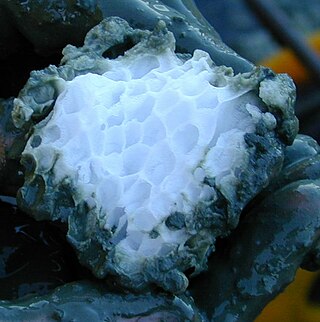Related Research Articles
Neutronium is a hypothetical substance composed purely of neutrons. The word was coined by scientist Andreas von Antropoff in 1926 for the hypothetical "element of atomic number zero" that he placed at the head of the periodic table. However, the meaning of the term has changed over time, and from the last half of the 20th century onward it has been also used to refer to extremely dense substances resembling the neutron-degenerate matter theorized to exist in the cores of neutron stars; hereinafter "degenerate neutronium" will refer to this.
Carbonic acid is a chemical compound with the chemical formula H2CO3. The molecule rapidly converts to water and carbon dioxide in the presence of water. However, in the absence of water, it is quite stable at room temperature. The interconversion of carbon dioxide and carbonic acid is related to the breathing cycle of animals and the acidification of natural waters.

Clathrate hydrates, or gas hydrates, clathrates, or hydrates, are crystalline water-based solids physically resembling ice, in which small non-polar molecules or polar molecules with large hydrophobic moieties are trapped inside "cages" of hydrogen bonded, frozen water molecules. In other words, clathrate hydrates are clathrate compounds in which the host molecule is water and the guest molecule is typically a gas or liquid. Without the support of the trapped molecules, the lattice structure of hydrate clathrates would collapse into conventional ice crystal structure or liquid water. Most low molecular weight gases, including O2, H2, N2, CO2, CH4, H2S, Ar, Kr, and Xe, as well as some higher hydrocarbons and freons, will form hydrates at suitable temperatures and pressures. Clathrate hydrates are not officially chemical compounds, as the enclathrated guest molecules are never bonded to the lattice. The formation and decomposition of clathrate hydrates are first order phase transitions, not chemical reactions. Their detailed formation and decomposition mechanisms on a molecular level are still not well understood. Clathrate hydrates were first documented in 1810 by Sir Humphry Davy who found that water was a primary component of what was earlier thought to be solidified chlorine.
Elastic properties describe the reversible deformation of a material to an applied stress. They are a subset of the material properties that provide a quantitative description of the characteristics of a material, like its strength.

Iron(II) fluoride or ferrous fluoride is an inorganic compound with the molecular formula FeF2. It forms a tetrahydrate FeF2·4H2O that is often referred to by the same names. The anhydrous and hydrated forms are white crystalline solids.

In chemistry, a water cluster is a discrete hydrogen bonded assembly or cluster of molecules of water. Many such clusters have been predicted by theoretical models (in silico), and some have been detected experimentally in various contexts such as ice, bulk liquid water, in the gas phase, in dilute mixtures with non-polar solvents, and as water of hydration in crystal lattices. The simplest example is the water dimer (H2O)2.

The atmosphere of Titan is the dense layer of gases surrounding Titan, the largest moon of Saturn. It is the only thick atmosphere of a natural satellite in the Solar System. Titan's lower atmosphere is primarily composed of nitrogen (94.2%), methane (5.65%), and hydrogen (0.099%). There are trace amounts of other hydrocarbons, such as ethane, diacetylene, methylacetylene, acetylene, propane, PAHs and of other gases, such as cyanoacetylene, hydrogen cyanide, carbon dioxide, carbon monoxide, cyanogen, acetonitrile, argon and helium. The isotopic study of nitrogen isotopes ratio also suggests acetonitrile may be present in quantities exceeding hydrogen cyanide and cyanoacetylene. The surface pressure is about 50% higher than on Earth at 1.5 bars which is near the triple point of methane and allows there to be gaseous methane in the atmosphere and liquid methane on the surface. The orange color as seen from space is produced by other more complex chemicals in small quantities, possibly tholins, tar-like organic precipitates.

Ice VII is a cubic crystalline form of ice. It can be formed from liquid water above 3 GPa (30,000 atmospheres) by lowering its temperature to room temperature, or by decompressing heavy water (D2O) ice VI below 95 K. (Different types of ice, from ice II to ice XVIII, have been created in the laboratory at different temperatures and pressures. Ordinary water ice is known as ice Ih in the Bridgman nomenclature.) Ice VII is metastable over a wide range of temperatures and pressures and transforms into low-density amorphous ice (LDA) above 120 K (−153 °C). Ice VII has a triple point with liquid water and ice VI at 355 K and 2.216 GPa, with the melt line extending to at least 715 K (442 °C) and 10 GPa. Ice VII can be formed within nanoseconds by rapid compression via shock-waves. It can also be created by increasing the pressure on ice VI at ambient temperature. At around 5 GPa, Ice VII becomes the tetragonal Ice VIIt.
Giacinto Scoles is a European and North American chemist and physicist who is best known for his pioneering development of molecular beam methods for the study of weak van der Waals forces between atoms, molecules, and surfaces. He developed the cryogenic bolometer as a universal detector of atomic and molecule beams that not only can detect a small flux of molecules, but also responds to the internal energy of the molecules. This is the basis for the optothermal spectroscopy technique which Scoles and others have used to obtain very high signal-to noise and high resolution ro-vibrational spectra.

Boron can be prepared in several crystalline and amorphous forms. Well known crystalline forms are α-rhombohedral (α-R), β-rhombohedral (β-R), and β-tetragonal (β-T). In special circumstances, boron can also be synthesized in the form of its α-tetragonal (α-T) and γ-orthorhombic (γ) allotropes. Two amorphous forms, one a finely divided powder and the other a glassy solid, are also known. Although at least 14 more allotropes have been reported, these other forms are based on tenuous evidence or have not been experimentally confirmed, or are thought to represent mixed allotropes, or boron frameworks stabilized by impurities. Whereas the β-rhombohedral phase is the most stable and the others are metastable, the transformation rate is negligible at room temperature, and thus all five phases can exist at ambient conditions. Amorphous powder boron and polycrystalline β-rhombohedral boron are the most common forms. The latter allotrope is a very hard grey material, about ten percent lighter than aluminium and with a melting point (2080 °C) several hundred degrees higher than that of steel.
A Bjerrum defect is a crystallographic defect which is specific to ice, and which is partly responsible for the electrical properties of ice. It was first proposed by Niels Bjerrum in 1952 in order to explain the electrical polarization of ice in an electric field. A hydrogen bond normally has one proton, but a hydrogen bond with a Bjerrum defect will have either two protons or no proton. D-defects are more energetically favorable than L-defects. The unfavorable defect strain is resolved when a water molecule pivots about an oxygen atom to produce hydrogen bonds with single protons. Dislocations of ice Ih along a slip plane create pairs of Bjerrum defects, one D defect and one L defect.
A hydrogen clathrate is a clathrate containing hydrogen in a water lattice. This substance is interesting due to its possible use to store hydrogen in a hydrogen economy. A recent review that accounts the state-of-the-art and future prospects and challenges of hydrogen storage as clathrate hydrates is reported by Veluswamy et al. (2014). Another unusual characteristic is that multiple hydrogen molecules can occur at each cage site in the ice, one of only a very few guest molecule that forms clathrates with this property. The maximum ratio of hydrogen to water is 6 H2 to 17 H2O. It can be formed at 250K in a diamond anvil at a pressure of 300MPa (3000 Bars). It takes about 30 minutes to form, so this method is impractical for rapid manufacture. The percent of weight of hydrogen is 3.77%. The cage compartments are hexakaidecahedral and hold from two to four molecules of hydrogen. At temperatures above 160K the molecules rotate around inside the cage. Below 120K the molecules stop racing around the cage, and below 50K are locked into a fixed position. This was determined with deuterium in a neutron scattering experiment.

Alan Kenneth Soper FRS is an STFC Senior Fellow at the ISIS neutron source based at the Rutherford Appleton Laboratory in Oxfordshire.

Paul Francis McMillan was a British chemist who held the Sir William Ramsay Chair of Chemistry at University College London. His research considered the study of matter under extreme conditions of temperature and pressure, with a focus on phase transitions, amorphisation, and the study of glassy states. He has also investigated the survival of bacteria and larger organisms (tardigrades) under extreme compression, studies of amyloid fibrils, the synthesis and characterisation of carbonitride nanocrystals and the study of water motion in confined environments. He has made extensive use of Raman spectroscopy together with X-ray diffraction and neutron scattering techniques.
Ice XIX is a proposed crystalline phase of water. Along with ice XV, it is one of two phases of ice directly related to ice VI. Ice XIX is prepared by cooling HCl-doped ice VI at a pressure above 1.6 GPa down to about 100 K. As of 2022, its crystal structure has not been elucidated.
Ice IV is a metastable high-pressure phase of ice. It is formed when liquid water is compressed with an immense force.
Vanessa K. Peterson is a Neutron Instrument Scientist, at the Australian Nuclear Science and Technology Organisation (ANSTO). She established an independent research program at ANSTO which specialised on improving understanding of energy systems and how they work. She manages the Echidna program, a high-resolution powder diffractometer, as well as Wombat - a high-intensity powder diffractometer. Peterson's expertise includes synchtron and laboratory x-ray techniques, as well as neutron powder diffraction, as well as single crystal x-ray diffraction.
Helen Maynard-Casely is an instrument scientist at the Australian Centre for Neutron Scattering at the Australian Nuclear Science and Technology Organisation (ANSTO) in Sydney, Australia. She has won numerous prizes and is an advocate for the participation of women in STEM.

Thomas Loerting is an Austrian chemist and associate professor at the University of Innsbruck. His research focuses on amorphous systems, the physics and chemistry of ice and chemistry at low temperatures.
Richard John Nelmes,, , is a British crystallographer, currently Professor Emeritus and Honorary Professorial Fellow in the School of Physics and Astronomy at the University of Edinburgh. As chair of the university's Centre for Science at Extreme Conditions (CSEC), he studies the behaviour of crystal structures and materials such as ice, methane, and silicon at pressures of up to 1 million times normal atmospheric pressure.
References
- ↑ "John Loveday's home page".
- 1 2 Loveday, J. S.; Nelmes, R. J. (2008). "High-pressure gas hydrates". Phys. Chem. Chem. Phys. 10 (7): 937–950. Bibcode:2008PCCP...10..937L. doi:10.1039/B704740A. hdl: 1842/3987 . PMID 18259632.
- ↑ Loveday, J. S.; Nelmes, R. J.; Guthrie, M.; Belmonte, S. A.; Allan, D. R.; Klug, D. D.; Tse, J. S.; Handa, Y. P. (2001). "Stable methane hydrate above 2 GPa and the source of Titan's atmospheric methane". Nature. 410 (6829): 661–663. doi:10.1038/35070513. PMID 11287946. S2CID 4416755.